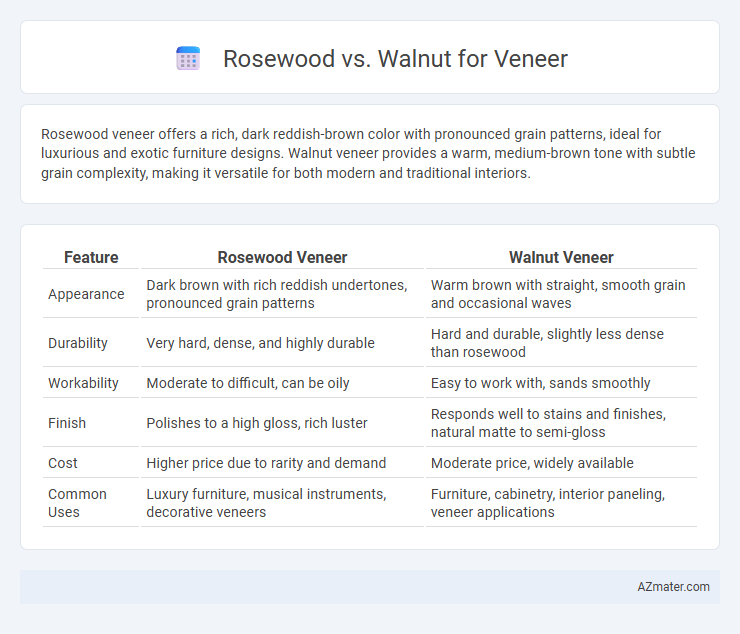Rosewood veneer offers a rich, dark reddish-brown color with pronounced grain patterns, ideal for luxurious and exotic furniture designs. Walnut veneer provides a warm, medium-brown tone with subtle grain complexity, making it versatile for both modern and traditional interiors.
Table of Comparison
| Feature | Rosewood Veneer | Walnut Veneer |
|---|---|---|
| Appearance | Dark brown with rich reddish undertones, pronounced grain patterns | Warm brown with straight, smooth grain and occasional waves |
| Durability | Very hard, dense, and highly durable | Hard and durable, slightly less dense than rosewood |
| Workability | Moderate to difficult, can be oily | Easy to work with, sands smoothly |
| Finish | Polishes to a high gloss, rich luster | Responds well to stains and finishes, natural matte to semi-gloss |
| Cost | Higher price due to rarity and demand | Moderate price, widely available |
| Common Uses | Luxury furniture, musical instruments, decorative veneers | Furniture, cabinetry, interior paneling, veneer applications |
Introduction to Veneer Woods: Rosewood vs Walnut
Rosewood and walnut are two prominent veneer woods valued for their unique grain patterns and rich colors in fine woodworking and furniture making. Rosewood veneer is known for its deep reddish-brown hues with dark streaks, offering an exotic and luxurious appearance, while walnut veneer features a warm, chocolate-brown tone with straight to slightly wavy grains, providing a classic and versatile finish. Both veneers are prized for durability and ease of finishing, influencing their selection based on aesthetic preferences and project requirements.
Visual Appeal: Grain Patterns and Color Differences
Rosewood veneer displays rich, dark brown to deep reddish hues with dramatic, irregular grain patterns that create a luxurious, exotic appearance ideal for statement furniture pieces. Walnut veneer features more uniform, straight grains with a warm, medium brown color that ages gracefully to a deeper shade, providing a classic and versatile aesthetic. The choice between rosewood and walnut veneers hinges on whether a bold, striking visual impact or a timeless, understated elegance is desired.
Durability and Hardness Comparison
Rosewood veneer exhibits higher hardness on the Janka scale, typically ranging between 1,600 to 2,200 lbf, compared to walnut's moderate hardness of around 1,010 lbf, making rosewood more resistant to dents and wear. Durability-wise, rosewood is dense and oily, which enhances its resistance to moisture and decay, whereas walnut, while still durable, is more susceptible to scratching and requires regular maintenance to preserve its finish. Choosing rosewood veneer is ideal for heavy-use furniture due to its superior hardness and longevity, while walnut offers a balanced mix of durability and ease of workability for decorative applications.
Workability and Finishing Qualities
Rosewood veneer offers a smooth, dense grain that provides excellent workability for intricate detailing and shaping, making it ideal for fine furniture and decorative applications. Walnut veneer is prized for its consistent texture and ease of sanding, allowing for superior finishing qualities with a rich, warm tone that enhances stain absorption and polish. Both woods respond well to hand and machine tools, but rosewood's natural oils can sometimes require specialized finishing techniques to achieve a flawless surface.
Cost Analysis: Rosewood vs Walnut Veneer
Rosewood veneer typically commands a higher price than walnut due to its rarity and distinctive grain patterns, making it a premium choice for luxury furniture and cabinetry. Walnut veneer offers a more affordable option with consistent availability and rich, warm tones suitable for a variety of design styles. Cost analysis reveals that for budget-conscious projects, walnut provides excellent value without compromising aesthetic appeal, while rosewood serves better high-end applications where exclusivity and visual impact justify the increased expense.
Sustainability and Sourcing Considerations
Rosewood veneer, sourced primarily from tropical regions, faces significant sustainability challenges due to its slow growth and overharvesting, leading to strict regulations and limited availability under CITES listings. Walnut veneer, often harvested from managed forests in North America and Europe, offers a more sustainable option with better-regulated sourcing and quicker growth cycles. Choosing walnut for veneer helps reduce ecological impact and supports responsible forestry practices compared to the more environmentally sensitive procurement of rosewood.
Common Applications in Furniture and Interiors
Rosewood veneer is prized for its rich, dark hues and dramatic grain patterns, making it ideal for luxury furniture, high-end cabinetry, and decorative wall panels. Walnut veneer offers a warm, smooth texture with subtle grain variations, commonly used in modern and mid-century furniture, flooring, and interior trim. Both woods enhance aesthetic appeal and durability, but rosewood suits statement pieces while walnut excels in versatile, everyday applications.
Maintenance and Longevity of Veneer Surfaces
Rosewood veneer offers moderate maintenance requirements due to its dense grain, which resists minor scratches and wear, enhancing its long-term durability. Walnut veneer, prized for its stability and fine texture, requires careful cleaning with non-abrasive products to preserve its smooth finish and prevent fading over time. Both veneers benefit from regular dusting and controlled humidity to maximize longevity, but walnut's resistance to warping gives it a slight edge in maintaining surface integrity over extended periods.
Pros and Cons: Rosewood Veneer
Rosewood veneer offers a rich, dark grain with striking patterns that enhance luxury furniture and cabinetry, prized for its durability and resistance to wear. However, it tends to be more expensive and harder to source sustainably compared to other veneers, raising environmental and ethical concerns. Its density can make it challenging to work with, requiring specialized tools and adhesives for optimal application.
Pros and Cons: Walnut Veneer
Walnut veneer offers a rich, warm tone with a straight, fine grain that enhances modern and classic furniture designs, making it highly versatile and aesthetically appealing. Its durability and resistance to wear contribute to long-lasting surfaces, although it can be susceptible to fading if exposed to direct sunlight over time. Cost-effective compared to exotic rosewood, walnut veneer provides a balance of beauty and practicality but may lack the unique, dramatic grain patterns that make rosewood veneers highly sought after.

Infographic: Rosewood vs Walnut for Veneer
 azmater.com
azmater.com